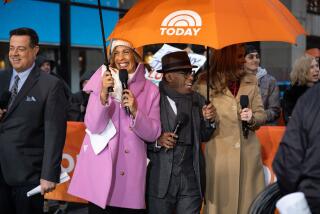Are These Heroes of Health Care Universal?
Sept. 4, 1975. Joining NBC is “Medical Story,” Abby Mann’s tough weekly anthology boldly portraying physicians as unworthy of the sainthood granted them on show after show.
Jan. 8, 1976. Leaving NBC is “Medical Story.”
*
Although many Americans complain bitterly about the quality of health care, most want their TV doctors--from Casey and Kildare to Dr. Quinn, “Chicago Hope” and “ER”--to practice medicine on a pedestal. Viewers will tolerate a few humanizing foibles that give healers texture, but heroes are what they crave.
And what they get in arresting, highly watchable “Hopkins 24/7,” a six-part documentary series from ABC News that’s shot in the intimate, fly-on-the-wall, fluid-camera, lens-in-your-face style of “48 Hours” on CBS.
The arena for this convergence of pristine, dedicated, caring, highly proficient lab coats is Johns Hopkins Hospital in Baltimore. Although the compassion and quality of care in these one-hour episodes may be representative of Johns Hopkins, arguably the nation’s most celebrated hospital, does it, by extension, also mirror what occurs at most urban medical institutions?
If not, shouldn’t ABC News have devoted its time and resources (its reporters and field producers spent three months at Johns Hopkins) to exposing problems patients encounter at more typical hospitals across the land and exploring solutions, instead of focusing only on the best?
Or what about six hours in prime time on the broader issue of the nation’s health-care crisis juxtaposed with competing reforms proposed by Al Gore and George W. Bush en route to Nov. 7. Yes, yes, borrrrrring. Not enough peekaboo “reality” to satisfy today’s ravenous appetites.
In any case, the documentary series that ABC News did make is good, at times extraordinary TV. Credit executive producer Rudy Bednar, producers Terry Wrong and Peter Bull and coordinating producer Severn Sandt.
They open tonight with rare access to a “morbidity and mortality” conference, a regular self-critical post-mortem review among doctors that we’re told occurs at hospitals everywhere. “I probably should have pushed harder to get him upstairs faster,” a surgeon acknowledges about a patient in a level of candor the public rarely hears from such practitioners.
“What is said here is meant never to leave this room,” says narrator Sylvia Chase.
Actually, at least some of what’s said in this series is clearly meant to travel far, such as Dr. Paul Colombani’s bitterness tonight over having to “play catch-up” with a critically ill little girl when her HMO is slow to authorize what he deems essential to treat her cancerous tumor. “I think it’s ridiculous that a high school clerk should be telling me I can or cannot do an operation,” Colombani complains.
And in Episode 5 of the series, a skeletal young woman with anorexia leaves Johns Hopkins months prematurely because she and her husband are broke and their insurance company won’t pay for more in-patient treatment that a hospital specialist tells the camera she must have to survive.
ABC News gets amazing access from Johns Hopkins, often with stunning results. The specter of possible staging does occasionally surface, as when a camera just happens to be in the home of a family when a doctor--who is wired for sound--calls from the hospital with a diagnosis.
Yet the tension and the emotion throughout “Hopkins 24/7”--including the concern of little Alex Moody’s parents as she approaches perilous brain surgery Thursday night--are real.
Study those faces. Talk about feeling someone’s pain. Scripted drama could not be more fixating or involving.
This is no monolith of happy endings. Bodies are zipped into plastic bags. Protruding from a sheet in a coming episode are the feet of a woman “Time of death, 2:19”) who arrived in full cardiac arrest, her painted toenails a tiny clue to the life she led into middle age.
Episode 4 brings the most remarkable segment of the series, with a camera somehow present when ponytailed Rick Montz, a noted surgical oncologist, tells a pretty young mother that her cancer has spread lethally, giving her a “limited time” to live. The emotion each must be feeling is submerged.
“Sorry, baby,” he says. “You tried,” she says. Montz shares what he is thinking. Yet what was in this woman’s mind, one wonders, when she signed off on this exceptionally intimate footage, allowing it to be telecast to strangers?
A cheerier fate may await Zach Chamberlin in Episode 3, as a Johns Hopkins medical team flies 200 miles to retrieve a donor’s healthy lungs designated for this shrunken 17-year-old in the hospital’s pediatrics unit. The lungs, which have a limited life for transplanting, are packed in ice. “Now,” says Chase, swelling the suspense, “the race home begins.”
If you’ve wondered what diseased lungs look like, get a gander at Zach’s.
And also see TV’s first sea turtle MRI. It occurs before surgery (“watch the flipper”), as fissures of levity appear in this somber but fascinating universe. That also includes a mortician who arrives after injuring himself when falling into an open grave during a funeral.
Despite such occasional black humor, there is clearly no resemblance here to “The Hospital,” Paddy Chayefsky’s dark satire about a New York medical center where a deranged killer runs amok avenging relatively healthy patients who have been allowed to die from staff neglect and incompetence.
There’s none of that in “Hopkins 24/7,” whose marquee of heroes tonight gives top billing to Dr. Edward Cornwell, chief of trauma surgery, who, beyond his stalwart performance in mask and gown, works selflessly on his own time to salvage youngsters from a crime-ridden underclass in the inner city where this hospital is located. How can you not be impressed?
Are the role-model doctors on the screen here themselves a separate class, though, or even remotely typical of the masses that practice medicine at U.S. hospitals? That is the question.
* The six-part documentary series “Hopkins 24/7” begins tonight on ABC. Part 2 airs Thursday at 10 p.m., with the remaining segments airing Wednesdays at 10 p.m.
*
Howard Rosenberg’s column appears Mondays, Wednesdays and Fridays. He can be contacted by e-mail at [email protected].
More to Read
The complete guide to home viewing
Get Screen Gab for everything about the TV shows and streaming movies everyone’s talking about.
You may occasionally receive promotional content from the Los Angeles Times.






